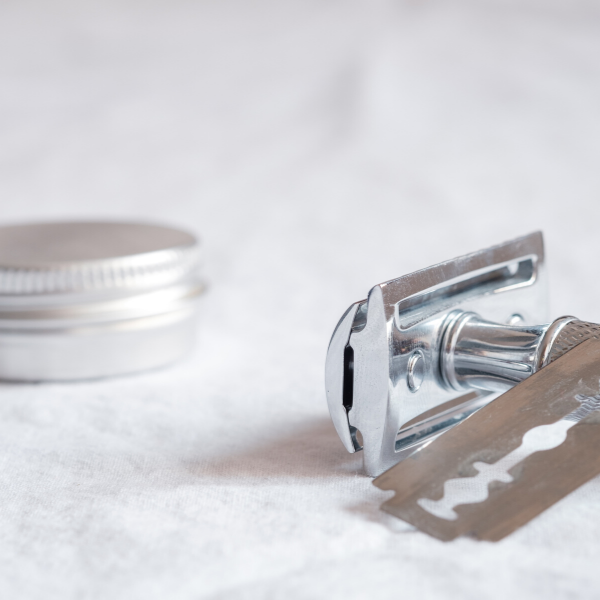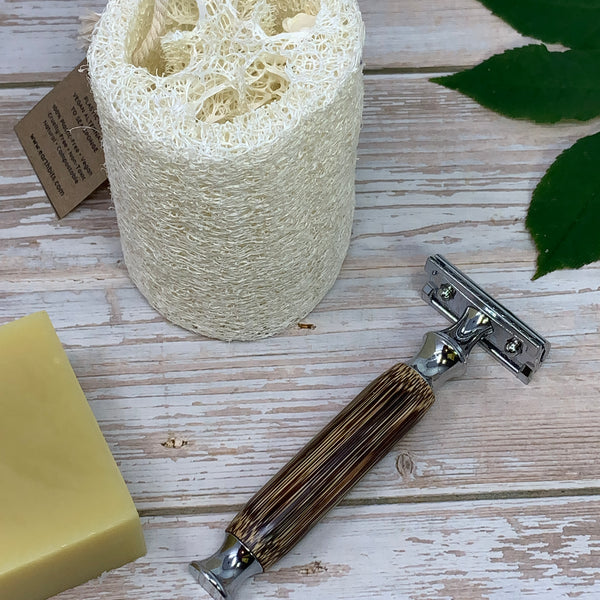We have probably all heard of safety razors. To be honest, the first time someone mentioned it to me as a possible eco-friendly alternative to disposable razors, the first thing that popped into my mind was an image of a stereotypical 1950’s barbershop, you know, the one with a red and white outside pole, a hairdresser with an apron holding astraight-razor among a row of men sat in chairs reading newspapers. Very Godfather-like!

I also had this idea that, not only was a product predominantly used to shave beards and moustaches, therefore basically of a so-called male product, but also that it would be very difficult to use and quite unsafe to handle.
The main thing that I found out when I started using one is not only that it’s perfectly gender-neutral, but indeed that it’s no more difficult or risky to use than a disposable one, and do not cut you any more than more conventional razors.
The problem with disposable razors

Razors are generally made out of plastic, and are not made to last very long at all. Big corporations have made shaving cheaper and far more disposable over the long term, and it has gotten to the point that some people have even gotten to using a razor only once or twice before tossing it. There’s obviously no need to stress out how unsustainable this is on environmental terms.
In the US, 2 billion disposable razors are thrown away every single year while in the UK, hundreds of millions are also tossed out.
But it’s not just a matter of quantity. It’s also about the materials they are made of. Disposable razors are usually made of many different components and it’s this mix of materials that make them very hard to be recycled. The handle is often made up of plastic, and more often than not it also contains rubber that allows easier and better grip. Then there is the head with metal blades embedded in a plastic frame. The hybrid set-up of these razors makes it incredibly difficult to separate different materials for recycling, so the majority end up in landfills or contaminating our water systems.
It doesn’t sound good at all does it? So what’s the solution? Well, there is. It is known as the Safety Razor.

This is a razor that is usually made out of metal, sometimes combined with other materials such as wood or bamboo, and it is basically the reusable version of a disposable shaving razor. As it is made of materials that are long-lasting and resistant, the only thing that needs to be changed every few weeks (or even longer, depending on how often they are used) is the razor’s blades.
Again, there are different blades available on the market but we recommend avoiding plastic ones as they go against the whole purpose of a reusable and non-wasteful alternative. The best types in our opinion are stainless steel blades, as they can be fully recyclable. Please make sure you do hand them in in a safe manner at your local recycling centre, the last thing you want is for a recycling operator to cut themselves with your used blades!
So if it’s so easy and good for the planet, why aren’t people a lot more people already converted to using one? Well, the main reason is probably that people still have a similar feeling to the one I had before I gave it a go: some people might feel that this razor requires a little more technical know-how than one might want when reaching for their morning shave. This together with a perceived sense of risk to getting cut more easily may put a lot of people off.
So here’s why I have decided to write this post, to debunk all these myths and to provide a full-on step by step guide on how to become a pro at using a safety razor and ditch all those wasteful disposable shaving blades once and for all!
Tips when using a Safety Razor
Using one of these might seem very intimidating at first, but once you get used to them, you realize that is is actually fairly simple. However, it is important to both go slow, and to use shaving cream. Since these razors are generally more rigid, it would be a mistake to use it in the same way that you would use a disposable razor.
Let’s start from the basics.
1. What makes a good shaving razor and how to choose one.

I personally think a double edge blade razor is the best razor anyone can use for a clean, smooth shave. This is because multi-bladed razors (which are usually also disposable) tend to go over your skin several times., and in doing so one blade pulls the hair up, while the other two cut through the hair. This can create a few issues, among which can cut the hair underneath the epidermis, increasing the risk of ingrown hair. Have you ever had red little bumps on your skin after shaving with a disposable razor? These are basically the irritated hair follicles around the ingrown hairs that have swollen up.
Unlike razors with multiple blades, a single blade safety razor is usually run along the skin at a 30-degree angle, without putting pressure thus allowing hairs to be cut without being pulled. This dramatically reduces the risk of ingrown hairs and skin irritation in general.
In conclusion, especially if you have sensitive or delicate skin, but even if you just want to take better care of your epidermis, a double edge single-bladed razor like this one is the best option available.
We particularly like the bamboo handled ones, as they allow a much softer grip, without irritating your hand’s skin, while at the same time guarantying a comfortable experience while shaving even the whole body, which may require a longer shaving session.
2. Step by step guide on using a safety razor.
- CHECK THE BLADES BEFORE USING YOUR RAZOR.
The best things that you can do is to make sure that the razor is sharp and fresh, to avoid razor burn. In order to do that, make sure you change the stainless steel blades every time they look a bit battered or not very sharp, in the same way, you would judge the blades of a plastic razor. This way you will avoid unnecessary skin irritation.
- APPLY SHAVING SOAP OR CREAM ON SKIN
Don’t forget to apply soap or shaving cream to the skin in an upward motion.
- LET YOUR RAZOR DO ITS JOB
Since the razor is heavier than a plastic one, it is also important to note that you do not have to apply that much pressure. Let the natural weight of the razor do that job for you. Applying too much pressure can cause cuts and other accidents, so just hold the handle firmly while taking short and smooth strokes along the skin. Take your time and move in small motions
- THE SECRET IS IN THE ANGLE
Hold the razor at a 30° angle: keep the angle of the head of the razor at about 30 degrees to the surface of the skin. The razor has a safety guard but it doesn’t bend in the same way a disposable razor does, so. Pull loose skin around areas like your knees, ankles and jawline tight to avoid any cuts or nicks.
- AFTER CARE FOR YOUR SKIN AND FOR YOUR RAZOR
Use cold water when you are done to wash up, pat dry, and use some natural moisturizer without any alcohol to treat the skin. Remove any excess hairs and shaving products from the razors with hot water and dry thoroughly with a clean cloth.
After you are done shaving, shake all the water off the razor for a few seconds. You just need a couple seconds of vigorously moving it with your wrist to get any trapped water off the blades. Pat every bit of your razor with a dry clean cloth (cotton ones are the best ones as they are great at soaking any extra water!). Store your safety razor in a dry place. Humidity and air moisture can causes the blades to go dull faster. To prevent the blades from rusting, you can also oil your razor with some almond or coconut oil at least once a month. Wipe off any excess oil before using the razor again.
- USE YOUR JEANS FOR SOME GOOD STROPPING!
Yes, you read it right! One trick to keep your blades healthy and living for longer is to strop them against the leg of your jeans (don’t wear them while doing it!) for about 20 times, on each side of the blade. Keep the razor bent at a 30° angle to avoid damaging your favourite trousers!
THAT’S IT REALLY! To be honest, once you get used to handling a safety razor, you will ask yourself why you’ve waited so long to get one!










Leave a comment (all fields required)